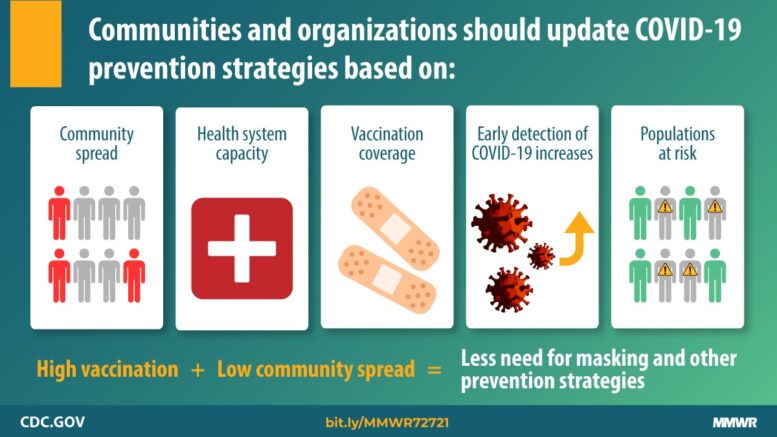COVID-19 vaccines authorized in the United States are effective against severe illness and death from SARS-CoV-2 infection; however, current U.S. coverage is uneven. Experts say that implementation of layered prevention strategies reduces SARS-CoV-2 transmission.
As Christie, et al. (2021) note, "Despite widespread availability, vaccine uptake has slowed nationally with wide variation in coverage by state (range = 33.9%–67.2%) and by county (range = 8.8%–89.0%). Unvaccinated persons, as well as persons with certain immunocompromising conditions (3), remain at substantial risk for infection, severe illness, and death, especially in areas where the level of SARS-CoV-2 community transmission is high. The Delta variant is more than two times as transmissible as the original strains circulating at the start of the pandemic and is causing large, rapid increases in infections, which could compromise the capacity of some local and regional health care systems to provide medical care for the communities they serve. Until vaccination coverage is high and community transmission is low, public health practitioners, as well as schools, businesses, and institutions (organizations) need to regularly assess the need for prevention strategies to avoid stressing healthcare capacity and imperiling adequate care for both COVID-19 and other non–COVID-19 conditions."
The authors continue, "The CDC recommends five critical factors be considered to inform local decision-making: 1) level of SARS-CoV-2 community transmission; 2) health system capacity; 3) COVID-19 vaccination coverage; 4) capacity for early detection of increases in COVID-19 cases; and 5) populations at increased risk for severe outcomes from COVID-19. Among strategies to prevent COVID-19, CDC recommends all unvaccinated persons wear masks in public indoor settings. Based on emerging evidence on the Delta variant (2), CDC also recommends that fully vaccinated persons wear masks in public indoor settings in areas of substantial or high transmission. Fully vaccinated persons might consider wearing a mask in public indoor settings, regardless of transmission level, if they or someone in their household is immunocompromised or is at increased risk for severe disease, or if someone in their household is unvaccinated (including children aged <12 years who are currently ineligible for vaccination)."
Although increasing COVID-19 vaccination coverage remains the most effective means to achieve control of the pandemic, additional layered prevention strategies will be needed in the short-term to minimize preventable morbidity and mortality, the researchers emphasize.
Reference: Christie A, et al. Guidance for Implementing COVID-19 Prevention Strategies in the Context of Varying Community Transmission Levels and Vaccination Coverage. Morbidity and Mortality Weekly Report. Vol. 70. July 27, 2021.
